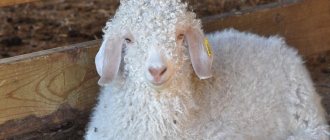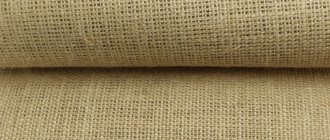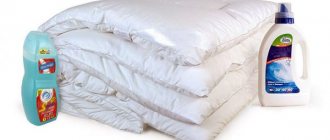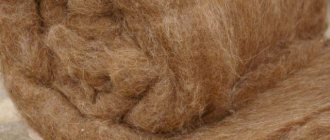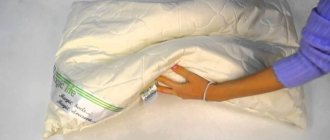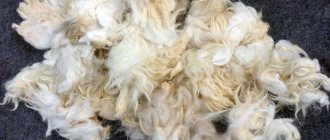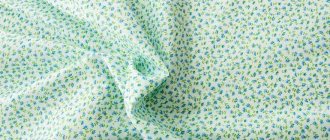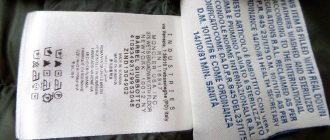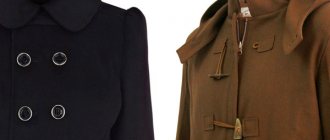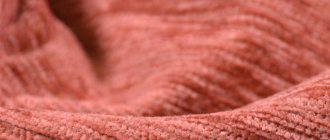What is “Laster” wool?
The source of raw materials for the production of Laster wool are various animals: rabbits, goats, llamas, camels and dogs. After shearing, the wool goes directly to the spinning mill. Since the yarn contains blades of grass, sticks and dirt, it is processed using ripping machines. At the next stage, repeated washing is carried out, which allows you to remove even the most minor stains.
After this, dyeing occurs at a temperature of 120 degrees. For 3 hours, the resulting raw materials are kept in a special solution with paint. Only after this the wool is sent to a carding machine, from which thin sheets of products emerge, from which bobbins are formed and placed in an airtight container. At the next stage, the wool is coated with artificial resins. During the processing process, the resin is wrapped in a thin film of fibers.
Main classification
Experts classify yarn depending on length, strength, ductility and color. Many ordinary consumers believe that the characteristics of wool depend on certain animals. Alpacas are distant relatives of camels. The fur of these animals is very durable, thin, long and light. This material is often used to make children's clothing. The palette has more than 20 colors, and synthetics and the wool of other animals are used for production.
This is due to the fact that the wool of this animal is very expensive. Merino sheep wool is very elastic and very durable. Therefore, it is the most expensive raw material for yarn production. These threads are used to create hypoallergenic items for children, as well as thermal underwear. In order to reduce the cost of products, they are mixed with different types of yarn. This article will tell you what Laster wool is and what advantages it has.
Yarn Vita Candy
178 m / 100 g. Recommended: knitting needles 3.5 - 4, hook 3.
Wool. The manufacturer characterizes it as Superwash, i.e. This yarn can be washed in the washing machine with a special detergent on the wool program.
Looking at the yardage, it may seem that the yarn is thick. This is wrong.
The thickness of the yarn is the same as classic wool with a yardage of 125 m/50 g.
But due to the fact that the thread is twisted very tightly, it is heavy, hence the small footage.
It is for this reason that I do not recommend knitting with it for children. It’s better to choose a lighter yarn.
In my opinion, you should take no more knitting needles than the recommended four.
The yarn is soft, silky, with a slight shine and... very slippery. Don't forget to carefully secure the knots!
Keeps its shape well due to its elasticity. Excellent for arans.
And its shine will perfectly emphasize the beauty of relief patterns. Openwork can also be used, but it must be taken into account that the canvas will turn out to be somewhat rough.
The yarn may prick. Depends on individual skin sensitivity. For those who are very sensitive, I would recommend wearing something under a knitted item.
Thanks to the superwash treatment, the item you knitted will not mat even after washing in the machine.
But this does not mean that it can be washed with ordinary powder. Wool is wool and the detergent must be very gentle.
Some knitters experience a chemical smell from wet items after washing. Don't worry - it will go away after drying.
A slight peeling is possible, which can be easily removed using a special machine.
I read that after the first wash the item stretched out, but subsequently did not change shape. I didn't notice this. The blouse that I knitted perfectly retained its shape, both after the first wash and subsequently.
Read this: DIY pom pom rug using wool threads and trash bags
In general, I have no complaints about the yarn, with one small “but” - despite the chic appearance of the yarn in the skein, the fabric does not look expensive. Therefore, I concluded for myself that I will not buy it again.
Wool specifics
During spring molting, you can comb out about 200 grams of fluff from one individual. Such products are famous for their incredible comfort and are also durable. The woven thread has a high degree of strength, and at the same time it turns out to be very thin. Users note that such items often develop tussiness where they come into contact with other items of clothing. Also, things made from this type of wool are afraid of high humidity.
The fur of Angora rabbits is very fluffy and soft. Angora is often used with other fibers that provide stabilizing properties. Angora goats are sheared from a special type of wool called mohair. This raw material is mixed with other types of threads, which strengthen the yarn and make it durable. The maximum mohair content is no more than 83% in items that are on sale.
For many people, the material from which the clothes are made is of fundamental importance. If wool is indicated on an item, it means sheep. This material requires careful care, as it can shrink and fall off when washed. Also, such yarn is in the low price segment, and at the same time it is very durable and warm. Therefore, it has gained wide popularity among buyers.
Tonina
Fineness is the cross-sectional value of an individual fiber; it is expressed in micrometers (µm). This is one of the important signs in the evaluation and classification of wool.
Sheep's wool
The sheared wool is sorted by quality, loosened and debris removed, washed to remove dirt and grease, and dried with hot air. Wool is divided into four types: Down - a thin, soft, crimped fiber that has no core layer. Transitional hair is thicker and coarser than down. The medullary layer occurs in places. The spine is a thick, stiff fiber with a significant core layer. Dead hair is a thick, coarse, straight, brittle fiber, the core layer occupies the largest part. The quality of sheep's wool is determined by two parameters - quality and impurities. In different places of the sheep's body, the quality of the wool is different. Numbers from 1 to 7 indicate a decrease in wool quality (the higher the number, the lower the quality). The best wool is taken from the neck, back and thighs.
Quality classification:
1-4 - uniform wool of different lengths, fleece; 5 - curls and coarser wool; 6-7 - awn and dead hair, hard and not durable.
After shearing a sheep, the amount of good wool is 75-80%, unsuitable 15-25%.
In our countries, the quality of wool and down is determined by :
- fineness; - length; - tortuosity; - fortress; — extensibility; — elasticity; — elasticity; - color; - shine; - humidity; - fat content.
The finest wool is produced by sheep of fine fleece breeds (25 microns and finer). From sheep of semi-fine wool breeds, wool with a fineness of 25.1 microns and coarser is obtained.
In our countries, depending on the fineness, wool is divided into 13 classes called qualities.
Quality classes:
| Quality (fineness class) | Wool fineness, microns |
| 80s | 14,5-18 |
| 70s | 18,1-20,5 |
| 64th | 20,6-23 |
| 60s | 23,1-25 |
| 58th | 25,1-27 |
| 56th | 27,1-29 |
| 50s | 29,1-31 |
| 48th | 31,1-34 |
| 46th | 34,1-37 |
| 44th | 37,1-40 |
| 40s | 40,1-43 |
| 36th | 43,1-55 |
| 32nd | 55,1-67 |
Abroad, wool is also divided into grades based on the measurement of wool diameter in microns. The classification varies depending on the breed of sheep.
For merino:
<17.5 - ultrafine merino 17.6-18.5 - superfine merino <19.5 - fine merino 19.6-20.5 - fine medium merino 20.6-22.5 - medium merino ) 22.6 < - strong merino, only in Australia
For other breeds:
<24.5 - fine 24.5-31.4 - medium 31.5-35.4 - semi-coarse 35.5 < - coarse Fine wool - consists of downy fibers, has a fineness of no more than 25 microns, no coarser than 60 quality, used for finishing work. Semi-fine wool - consists of fibers coarser than fine wool, a mixture of transitional fibers and coarsened fluff, fineness from 25 to 34 microns, not lower than class 46, used for finishing work, sometimes requiring shearing of the final product. Semi-coarse wool - consists of wool fibers with a fineness of 31.1-40 microns, quality 48 and coarser, used for making felt boots, overcoat drape of antique toys. Coarse wool - it contains all types of fibers: fluff, transitional fibers, awns, often dry or dead hair, fineness from 40 microns and coarser, most often not dyed, used for making felt boots and carpets. Sliver - combed wool, primary cleaning, used as a basis for felting, followed by the application of wool of other colors, fineness 23-25 microns, vegetable impurities up to 1%. Tow - small and large short fibers that remain after combing wool into a combed strip, used for making felt, as a backing in the manufacture of rugs, and also for stuffing toys, the fineness varies from 2 to 60 microns. Bleached wool is stretched, combed and bleached wool, used to create a light background and for home dyeing, fineness 18-20 microns.
| Coarse wool | Semi-coarse wool | Semi-fine wool | Fine wool |
Average fiber fineness: fluff 10 - 25 microns; transitional hair - 30 - 50 microns; spine - 50 microns or more.
Wool is classified according to the length of its fibers (from 20 to 450 mm):
short-fiber - length up to 55mm, used for the production of thick and fluffy hardware yarn; long-fiber - length more than 55 mm, used for the production of thin and smooth combed yarn.
The finer the wool, the softer it is, while coarser varieties are less prone to matting.
Camel's wool
| Rough hair | Soft undercoat | Baby camel fur |
Camel wool consists of coarse hair and soft undercoat-fluff. The fur of camels is especially soft. From one camel you can get up to 7 kg of fiber per year. The structure is very similar to cashmere wool.
Camel hair is hollow inside and has additional heat-insulating properties. Camel wool is more than twice lighter than sheep's wool, more elastic, durable and soft, fineness from 14 to 22 microns. It does not electrify at all and does not cause allergies.
Fineness is one of the important systematic characteristics in the evaluation and classification of sheep and wool. It is determined by measuring the cross-sectional diameter of the wool fiber and is expressed in thousandths of a millimeter - micrometers (µm).
The fineness of the wool depends on the breed, feeding and housing conditions, the sex of the animals, their age and individual characteristics. Internationally, the most commonly used classification method is the English system. It is classified as follows:
| Coat type | Fineness class | Wool fineness, microns | |
| from | before | ||
| Extra thin | 80s | 14,5 | 18,14 |
| Super thin | 70s | 18.15 | 20,59 |
| Thin | 64th | 20.6 | 22,04 |
| Semi-thin | 62nd | 22,05 | 23,49 |
| Semi-thin | 60s | 23,5 | 24,94 |
| Semi-thin | 58th | 24,95 | 26.39 |
| Semi-thin | 56th | 26.40 | 27.84 |
| Semi-thin | 54th | 27.85 | 29.29 |
| Semi-thin | 50s | 29,3 | 30,99 |
| Rough | 48th | 31,0 | 32.69 |
| Rough | 46th | 32,7 | 34.39 |
| Rough | 44th | 34,4 | 36.19 |
| Very rude | 40s | 36,2 | 38.09 |
| Very rude | 36th | 38.10 | 40,2 |
| Very rude | 32nd | >40.20 | |
Fine wool consists of downy fibers with a fineness of no more than 25 microns (no coarser than class 60. The length of the wool in the staple is 7-9 cm. Based on quality indicators, fine wool is divided into merino and non-merino. Merino wool is white, soft, elastic , well balanced in fineness and length, contains a sufficient amount of fat.
Non-merino wool differs from merino wool by the insufficient uniformity of wool fibers in fineness and length, and by less crimp.
Features of wool
Many beginning needlewomen are interested in what Laster wool is and what properties it has. Wool is the hair of various animals, suitable for woolening and spinning. In order to understand what Laster wool means, it is necessary to get an idea of its chemical and physical composition. The main characteristics of wool are determined by the chemical composition and structure of the hair shaft. The curdling process is carried out due to the adhesion of the scales that are located on the surface of the rod. If washing conditions are not met, this leads to the formation of pellets and subsequent shrinkage of the product.
The core inside is completely empty, which explains the lightness of the yarn. The fibers have a porous structure, so they perfectly retain and absorb moisture from the air. Therefore, moisture evaporates very slowly from clothing and does not allow the body to cool down. Wool fibers are highly elastic, so such products are not subject to deformation. Answering the question of what “Laster” wool is, we can say that it is a yarn that has an increased shine, does not pill, does not shrink and does not prick. In addition, products made from this material have advantages that are characteristic of ordinary wool.
Differences between “Laster” wool and classic wool
After coating the product with polymer resins, the color becomes more saturated and rich. Regular wool has a matte effect, so it rarely comes in bright colors. When knitting, Laster wool glides a little on the knitting needles because it is silky and very soft. Classic wool has low hygroscopicity and thermal conductivity, which is due to the low porosity of the fibers. The price of Laster wool is higher than regular wool, since during the processing of the material about 3% of the original weight is lost. Regular wool fibers are covered with a large number of scales, which form pellets and irritate the skin.
Whose wool is laster yarn made from?
April 10, 2021 Sometimes there are riddle words in yarn compositions. For example, laster wool - what is it and what is it eaten with? Let's figure it out.
Luster wool (luster in English means “shine”, “gloss”) is part of such popular threads as VITA Brilliant and VITA Brilliant print, VITA Sapphire.
And VITA Diamond is a 100% wool laster. Just look at the names: they all “shine”: brilliant – “diamond”, diamond – “diamond”, sapphire – “sapphire”. This is no accident. Thread with laster wool fibers is distinguished by its shine - not metallic, like Lurex, but pleasant, noble, and refined. And ordinary wool, as you, of course, have noticed, does not shine at all.
Further. Precious stones are known to be durable. What could be stronger than diamond? And laster wool yarn has the same quality. You can safely wash things knitted from this yarn even in a machine! They will not “sit down”, will not lose their appearance, and will not be covered with nasty pellets for a long time.
Just try washing something made from classic wool in the machine - but try it only if you want to end up with well-matted felt!
Lastly, laster wool fibers—unlike regular wool fibers—are extraordinarily smooth to the touch and do not irritate the skin.
What is the secret of laster wool - shiny, durable and not scratchy?
Here's the thing. Remember the television advertisements for the “magic” shampoo that promises to make your hair soft and silky by smoothing out the scales on it? They also show what human hair looks like under a microscope. And wool is hair. Consequently, the fibers of ordinary wool are also completely covered with scales. And it is they who are “to blame” for the fact that classic wool does not shine (the scales do not reflect light well), falls off when washed (the scales firmly cling to each other) and itches (everything is clear here - the scales bristle and irritate the skin).
I don’t know how the shampoo mentioned above smoothes out the scales on the hair. But I know exactly how yarn manufacturers make wool fiber smooth. It turns out that the wool is first treated with acid, which burns the tips of the scales. And then the fibers are coated with a special compound (sealing agent) - with its help, small irregularities on the fibers are “healed”, achieving ideal smoothness.
This is how simple wool (and no matter what animal) is turned into laster wool, from which warm, beautiful, durable, hypoallergenic wool yarn is made.
I strongly advise you to try working with yarn that contains laster wool at least once in your knitting life. I'm sure you won't regret it 
Or maybe you have already become acquainted with a laster? Please share your impressions in the comments!
Sincerely yours, Natalya VseNitki
User reviews
Many users say that working with such material is very convenient and comfortable. When choosing yarn, you need to focus on what properties the finished product should have. There is an ideal Laster wool for every occasion. Reviews from many customers report that the yarn is not scratchy and does not form pellets when rubbed. Also, users note that woolen products do not shrink and retain their original shape perfectly. Most needlewomen claim that this yarn is pleasant to work with, since it is ideal for creating relief patterns. Also, Laster wool perfectly retains its volume after washing.
Many women recommend using this wool to create children's clothes, since the material does not cause an allergic reaction and does not irritate delicate skin. These threads can be used to knit all types of clothes that are extremely comfortable and warm. Merino wool "Laster" allows you to create beautiful patterns not only with knitting, but also with crochet. Things made from this material have a beautiful shine, have a long service life and look great. This article contains comprehensive information about what it is - “Laster” wool.
100% wool
Name
Composition Meterage Meterage per 50g Recommended knitting needles and crochet hook
CANDY
100%SW wool 178 m/100 g. 89 m knitting needles 3.5 - 4, hook 3
Pure Wool
100% wool 250 m / 100 g. 125 m knitting needles 3.5 - 4, hook 4
Diamond
100% wool laster 300 m / 100 g. 150 m knitting needles 3 - 3.5, hook 3.5
ALPACA WOOL
40% alpaca, 60% wool 300 m / 100 g. 150 m knitting needles 3 - 3.5, crochet hook 2.5
Caprice Lux
100% wool laster 400 m/100 g. 200 m
knitting needles 2.5 - 3, hook 2
Cassandra
100% wool laster 400 m / 100 g. 200 m knitting needles 2 - 2.5, hook 2.5
CORONA
100% wool 200 m / 50 g. 200 m knitting needles 2.5 - 3, hook 2
Merino Soft
100% merino wool laster 300 m / 50 g. 300 m knitting needles 1.5 - 2, hook 2
